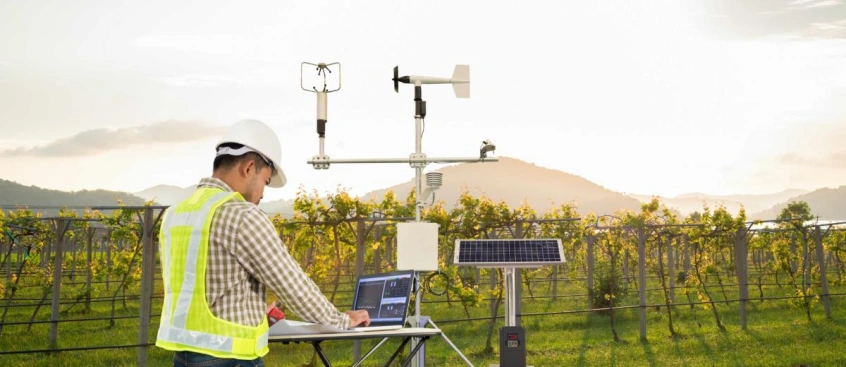
All about SMART Farms – Sustainable, Manageable, Accessible, Rural Technologies
Jan 15 2021

Agtech and research SMART Farms go hand in hand, testing a range of technologies, and developing cutting-edge new tech in partnership with ag industries. We explore the benefits ofSMART Farms for producers and ag industries.
While research farms have been around for more than 100 years, it was the rollout of the National Broadband Network (NBN) in 2010 that gave birth to the first SMART Farm concept in Australia. Now most states and territories have demonstration SMART farms showcasing emerging ag technologies.
SMART Farms are where producers and ag industries can explore potential solutions for their enterprise and where ag researchers and developers go to trial their ideas. Importantly, they connect researchers with students, producers, industry and the community.
For primary producers, the investment in this type of research on SMART Farms is being driven by the need to improve yields, quality, and on-farm efficiencies helping to solve some of farming’s most complex problems.
Australia’s first SMART Farm
When the northern NSW city of Armidale was chosen as a first release site for the NBN in 2011, the opportunities for farming were not top of mind. However, Professor David Lamb and his colleagues at the University of New England’s Precision Agriculture Research Group (PARG) immediately grasped the significance.
They jumped at the chance to bring precision ag technologies together, such as yield monitors, EM38 soil moisture sensors, and satellite remote sensing data.
It seems like a lifetime ago, but back then the task of getting data off sensors and into the hands of service providers meant time in the car, or mailing disks or DVDs.
The group also recognised the potential for stock tracking, and labour-intensive tasks such as checking watering points and weighing stock. For agronomists, vets, mechanics and other professionals supporting ag industries, they saw opportunity for consultations via video conferencing, saving hours behind the wheel and improving their ability to service their clients.
The PARG group set about transforming the university’s 1800ha Kirby Farm into a SMART Farm – a network of soil, plant, weather, animal, machinery and other asset sensors, designed to stream data into a ‘telemetry backbone’.
Ten years on with ag industry-focused research
Dr Rachelle Hergenhan is the UNE SMART Farms Industry Engagement Manager. She says that the tech has developed considerably from those early days.
“The idea with the telemetry backbone was that you could plug different sensors in as needed. They were installed around 2011/2012 so, in terms of tech lifespan it’s quite a while ago,” she says. “Now there is newer technology that’s cheaper and easier to use, and you can use a range of sensors because networks such as LORA are open, not proprietary, as others were initially.”
As the tech has developed and gone more mainstream, so too, has the focus of the research conducted on the farm.
“In the early days there was a lot of research looking at monitoring livestock, particularly livestock tracking,” Dr Hergenhan says. “This told the user where the animals were within a paddock. That has now developed further into monitoring individual animals for health and welfare measures.”
“For example, Dr Jamie Barwick from the PARG group here has been using AWI Smart ear tags to research individual animal movements and behaviour patterns, to determine the animal’s health and welfare status at a given point in time,” she says. “The AWI tags combine an accelerometer (measuring the acceleration of a moving animal) with proximity and position data to track the movement and activity of the animals and the interactions between them. If an animal is not moving, or moving more or less than usual, it can alert a producer to a potential issue with the health of their flock.”
At UNE’s 740ha 1000-head research feedlot, Tullimba, GrowSafe feeders are used to monitor individual animal feed intake and allow calculation of breeding values for feed efficiency in beef cattle, while GreenFeed units allow measurement of methane emissions from individual animals. Tullimba is used by industry, researchers and commercial beef producers to investigate issues such as feed efficiency, behaviour, animal welfare and feedlot management.
The UNE team are also exploring agtech for pasture management, using weather data, satellite mapping and ground truthing to support producers to make better decisions about grazing management and maintaining ground cover.
SMART Farms are now operational or in development across most states and territories in Australia, operated by universities, industry and government departments. They support a range of disciplines including agriculture, natural resource management, poultry, dairy, horticulture, precision agriculture and zoology.
SMART Farms around Australia
- University of New England SMART Farms
- The GATE
- Digifarm
- On-Farm IoT Trial
- Dairy Australia SMART Farms
- Victoria Longerenong Data Farm
- WA Muresk Institute Smart Farm Demonstration Site
- South Australia Demonstration Farms

The Food Agility Cooperative Research Centre’s Virtual Summit includes a panel session on The Rise and Rise of the SMART Farm. Find out more and register here.
Posted in Farmer Advice
You Might Also Like
Jul 23 2025
Low yields from wheat production? Here’s why.
For the past two decades, agronomists and farmers have been trying to solve the problem of low yields using Variable Rate Fertilisation application. However, yield is only half of the equation. In-field…
Read MoreMay 25 2025
Get more from your livestock data with these six agtech solutions
Farmers across Australia are producing more data than ever. But much of it remains frustratingly siloed. Here’s how you can get the most from your data as a livestock producer.
Read MoreMay 20 2025
Purchasing AgTech? Ask yourself these five questions first.
Whether it’s your first time, or you’ve already got plenty of technology in operation – asking the right questions ensures you take the best approach.
Read MoreApr 22 2025
Building farm data trust
At AgTech Finder we ask vendors to provide their data policies so that farmers can make informed choices about agtech and be comfortable about the way their data is being collected and…
Read MoreList your company on AgTech Finder.
AgTech Finder helps Australian Farmers and producers find the product that’s right for them.
Register now to be a part of the community, get access to a national platform and start gaining insights to improve your products.
